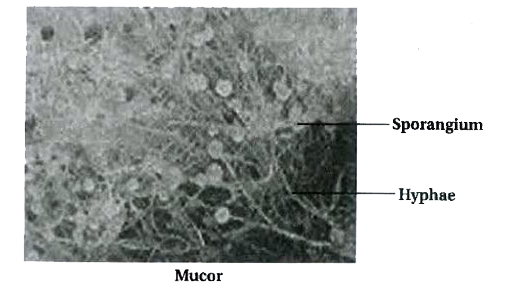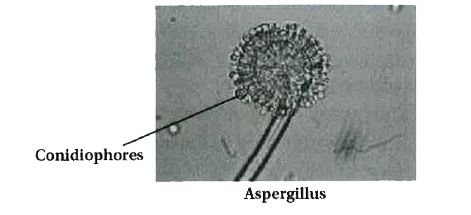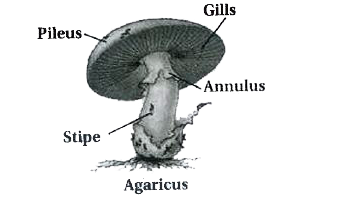Disease caused by phycomycetes.Solution in Gujrati
Example : Some common examples are Mucor, Rhizopus (the bread mould) and Albugo (The parasitic fungi on mustard). Disease caused by the members of Phycomycetes are white rust (Albugo), late blight of potato (Phytophtora infestants), down mildew (peronosphora parasitica) etc.

(B) Ascomycetes : Commonly known as Sac-fungi, the ascomycetes are mostly multicellular eg. penicillium, or rarely unicellular eg. yeast (saccharomyces).
Mode of nutrition : They are saprophytic, decomposers, parasitic or coprophilous (growing on dung).
Body organisation : Mycelium is branched and septate.
It may consist of distinct hyphae or the some may aggregate to produce prosonchyma
(It is formed of distinct hyphae running together in parallel) and pseudoparenchyma
(It is false parenchyma formed by close parking and fusion of hyphae).
Reproduction :
Asexual reproduction : The asexual spores are conidia produced exogenously on the special mycelium called conidiophores.
Conidia on germination produce mycelium.
Sexual reproduction : Sexual spores are called ascospores which are produced endogenously in sac like asci (singular ascus).
These asci are arranged in different types of fruiting bodies called ascocarps.
Example : Aspergillus, Claviceps and Neurospora.

Economic importance : Neurospora is used extensively in biochemical and genetic work.
Many members like morels and truffles are edible and are considered delicacies.
(C ) Basidiomycetes :
Common characters : Commonly known forms of basidiomycetes are mushrooms, bracket fungi or puffballs.
Habitat: They grow in soil, on logs and tree stumps and in living plant bodies as parasites eg. rusts and smuts.
Body organizations : The mycelium is branched and septate.
Reproduction: The asexual spores are generally not found but vegetative reproduction by fragmentation is common.
The sex organs are absent but plasmogamy is brought about by fusion of two vegetative or somatic cells of different strains or genotypes.

The resultant structure is dikaryotic which ultimately gives rise to basidium.
Karyogamy and meiosis take place in the basidium producing four basidiospores.
The basidiospores are exogenously produced on the basidium (pl. basidia).
The basidia are arranged in fruiting bodies called basidiocarps.
Example : Agaricus (mushroom), ustilago (smut), puccinia (rust fungus), Amanita (toad stools) bracket fungi, Lycoperdon (puftballs).
(D) Deuteromycetes :
Common characters : Commonly known as imperfect fungi because only the asexual or vegetative phase of these fungi are known.
When the sexual forms of these fungi were discovered they were moved into classes they rightly belong to.
It is also possible that the asexual and vegetative stage have been given one name (and placed under deuteromycetes) and the sexual stage another (and placed under another class).
Later when the linkages were established, the fungi were correctly identified and moved out of deuteromycetes.
Once perfect (sexual) stages of members of dueteromycetes were discovered they were often moved to ascomycetes and basidiomycetes.
The deuteromycetes reproduce only by asexual spores known as conidia, The mycelium is septate and branched.
Some members are saprophytes or parasites while a large number of them are decomposers of litter and help in mineral cycling
Examples : Alternaria, Colletotrichum and Trichoderma.
Topper's Solved these Questions
- BIOLOGICAL CLASSIFICATIONBOOK - KUMAR PRAKASHANCHAPTER - BIOLOGICAL CLASSIFICATIONEXERCISE - SECTION - B (DIFFERENCE/SCIENTIFIC REASONS)
14 Videos
- BIOLOGICAL CLASSIFICATIONBOOK - KUMAR PRAKASHANCHAPTER - BIOLOGICAL CLASSIFICATIONEXERCISE - SECTION - C (DEFINITION/EXPLANATION - TERMS/FULL NAME/IMPORTANCE/CONTRIBUTION OF SCIENTISTS)
34 Videos
- ANIMAL KINGDOMBOOK - KUMAR PRAKASHANCHAPTER - ANIMAL KINGDOMEXERCISE - OBJECTIVE SECTION (FILL IN THE BLANKS)
10 Videos
- BIOMOLECULES BOOK - KUMAR PRAKASHANCHAPTER - BIOMOLECULES EXERCISE - QUESTION PAPER (DESCRIBE IN DETAIL):
1 Videos
Similar Questions
Difference between Three Domains
View SolutionDefinitions/Explanation:
Paramylon
View SolutionTeeth are modified ........... which are ........... directed
View SolutionExplain chemical analysis.
View SolutionPhycomycetes
View SolutionThe disease caused caused by virus is:
View SolutionPhycomycetes are characterised by
View SolutionCreutzfeldt Jakob Disease (CJD) is a transmissible disease caused by a
View SolutionCausative agent of a protozoan disease which cause amoebiasis is :-
View SolutionPhycomycetes live as
View Solutionरेबीज रोग किसके कारण होता है? इस रोग के लक्षणों का उल्लेख कीजिए।
View Solutionकुछ सामान्य बीमारियों को वर्गीकृत करें जो कारणात्मक जीवों के द्वारा होती हैं?
View Solutionजीवाणु द्वारा मनुष्य में होने वाली किसी बीमारी (रोग) का नाम बताइए।
View Solutionकिस ग्रन्थी के अल्पस्रावण के फलस्वरूप टिटेनी रोग उत्पन्न होता है?
View SolutionMatch the following disease factors with the diseases caused by them.
View Solution
